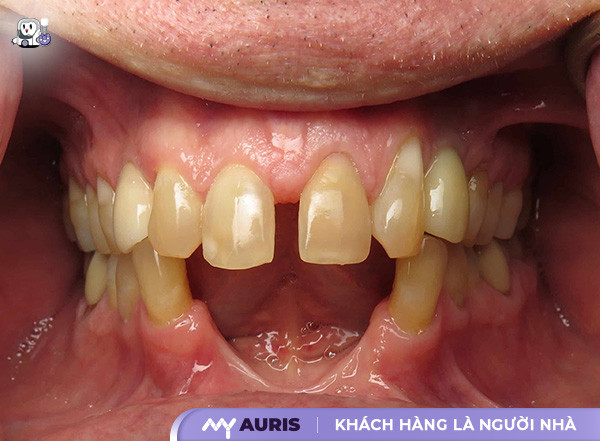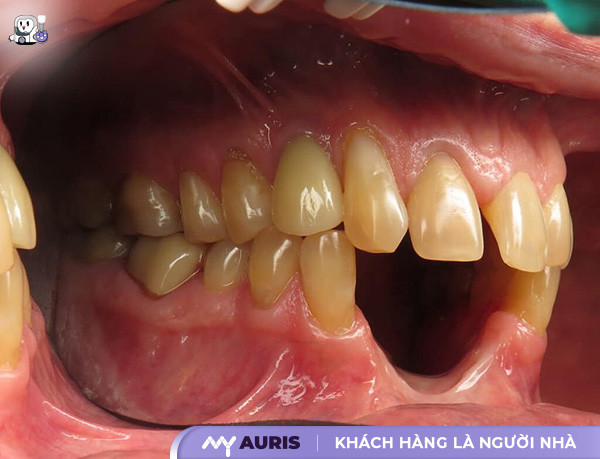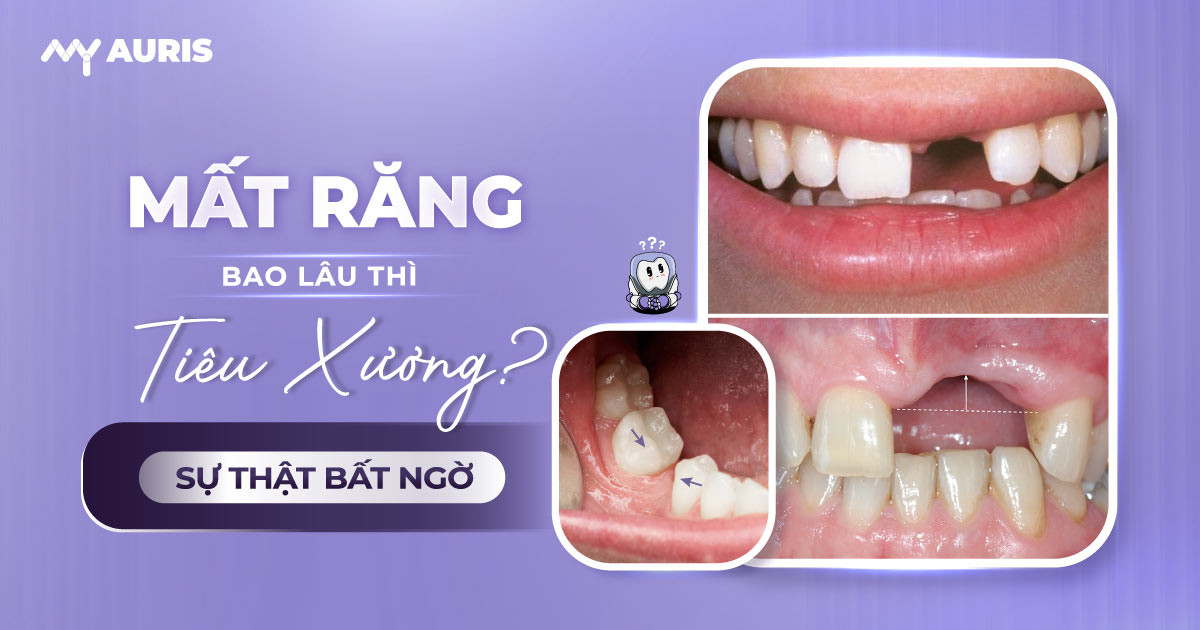Jawbone resorption occurs silently and gradually, often going unnoticed by many until they experience chewing problems or changes in facial shape. Understanding jawbone resorption, its various forms, and preventative solutions is crucial for long-term oral health. My Auris will provide detailed information on jawbone resorption, helping you better understand this process and how to prevent it.
What is Jawbone Resorption?
Jawbone resorption, also known as alveolar bone resorption, is the phenomenon where the bone supporting the teeth decreases in density and quality, typically occurring in both the upper and lower jaws. As this process progresses, the gums tend to recede, exposing the tooth roots, leading to facial asymmetry such as a crooked face, sagging, premature aging, and severely affecting the bite.
Tooth loss means the jawbone at that site no longer bears chewing forces, thereby stimulating bone destruction. Within the first 3 months after tooth loss, bone density begins to decline. On average, you can lose up to 25% of the bone volume at the site of the lost tooth within 1 year. After 3 years, this figure can increase to 45–60%, causing significant jawbone degradation.
Periodontitis is a prolonged inflammatory condition around the teeth, causing gum recession, exposing tooth roots, and creating conditions for bacteria to attack the bone and ligaments surrounding the teeth. Over time, these tooth-supporting structures will be destroyed, leading to loose teeth, loss of attachment, and eventual tooth loss.

Types of Jawbone Resorption After Tooth Loss
After tooth loss due to age or accident, if dental implants are not placed promptly, the risk of jawbone resorption can occur rapidly. This is a silent process but severely affects aesthetics, communication ability, and chewing function. Below are common types of bone resorption that need to be identified early:
Horizontal Jawbone Resorption
In this stage, the jawbone at the site of the lost tooth tends to narrow horizontally, reducing the width of the bone foundation. This imbalance causes adjacent bone areas to expand and encroach upon the resorbed space, leading to misaligned teeth, tilting, irregular dental arch, directly affecting facial aesthetics and self-confidence in communication.
Vertical Jawbone Resorption
The jawbone beneath the gum line can sink, creating a significant disparity compared to adjacent bone areas. The gum tissue at the site of bone resorption also atrophies, affecting the foundation for future dental prosthetics, especially when considering implant placement.
Sinus-Related Bone Resorption
In cases of upper molar loss, the maxillary sinus tends to descend, thinning the bone foundation and making dental implant placement more challenging. If left untreated, an enlarged maxillary sinus can affect the bone structure of the nose and cheeks.
Full Facial Bone Resorption
When multiple teeth are lost in both the upper and lower jaws, the bone resorption process causes the mouth area to sink, and deep wrinkles appear around the lips and cheeks. The most noticeable manifestation is a face that appears older than its age, significantly impacting aesthetics and quality of life.
If not addressed in time, widespread bone resorption can advance close to the nerve canal, causing pain, numbness, and affecting the feasibility of dental implant placement. Restoring the jawbone in such cases becomes much more complex and costly.

How Long After Tooth Loss Does Jawbone Resorption Begin?
After tooth extraction, jawbone resorption doesn’t happen immediately but is a silent and often unnoticed process. According to dental experts, approximately 3 months after tooth loss, bone density begins to decrease. By the 6th month, about 25% of the alveolar bone may have been lost. If jawbone resorption is not treated promptly, the bone loss rate after 1 year can reach 45–60%.
However, the rate of bone resorption is not the same for everyone. It depends on various factors such as individual constitution, overall health status, eating habits, and the level of daily oral hygiene.

Effective Restoration Solutions After Tooth Loss to Prevent Jawbone Resorption
Jawbone resorption is a serious consequence of tooth loss, affecting facial aesthetics and chewing ability. To minimize this condition, dental experts recommend placing dental implants as soon as possible after tooth extraction.
One of the most prominent methods today is implant placement – an advanced dental restoration technique where a titanium post integrates directly into the jawbone. This helps maintain bone structure, restores chewing function up to 90%, and significantly prevents bone resorption.
Dental implants not only help preserve surrounding natural teeth but also provide natural aesthetics, lasting for decades with proper care. Furthermore, oral hygiene after implant placement is very simple and does not cause discomfort like traditional removable dentures.
With numerous outstanding advantages, dental implants are the comprehensive solution for those seeking an optimal method for restoring lost teeth – helping you regain a radiant smile, enjoy delicious food, and maintain long-term oral health.
Frequently Asked Questions About Minor Surgery
How long does it take to recover after apicoectomy?
The healing time after apicoectomy usually lasts from 7 to 14 days, depending on factors such as: The extent of damage to the root area. The surgical technique and the surgeon’s skill. The patient’s post-apicoectomy dental care regimen.
Some signs that the wound has healed: Gums are no longer swollen or red. The treated area is pain-free. Normal chewing can be resumed without hindrance.
Are there complications with cyst removal and apicoectomy?
The procedure of cyst removal and apicoectomy is now quite commonly performed at reputable dental clinics with a high degree of safety. However, like any minor surgery, there is still a risk of complications such as:
Infection in the treated area if not properly cleaned
Prolonged bleeding due to unstable wound
Nerve damage if the nerve near the apex is affected
Slight tooth mobility after surgery
How to care for teeth after apicoectomy?
Proper care after cyst removal and apicoectomy helps speed up recovery and limit complications. Some basic guidelines:
Rinse your mouth with physiological saline or mouthwash as prescribed by your doctor for gentle antiseptic action.
Prioritize soft, liquid foods such as porridge, soup, and avoid hard or excessively hot/cold foods.
Drink plenty of plain water to keep the oral cavity clean.
Limit strenuous activity during the first 1-2 days and get adequate rest to help your body adapt to the recently treated tooth area.





